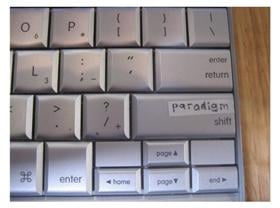If one is looking for evidence that parallel universes exist, one need only look at this past week in my life. I had the opportunity to participate in two separate faculty development activities – one on our own campus and one at the University of Mary Washington. The two activities provide an interesting continuum of faculty adoption of Web 2.0 processes into teaching and learning.

At our own institution, we ran a week-long Summer Institute with twenty faculty participants. The theme for this year’s CTE Summer Institute on Teaching and Learning was “Reflection, Alignment, and Engagement: 3 Keys to Better Learning.” A key focus for this institute was the teaching philosophy. As our website stated:
How we think about teaching and learning impacts the decisions we make about our course design, classroom teaching and how we interact with our students. How do we view our role as instructors? How do we view our students as learners? What are the conditions that are conducive to learning? Sometimes our focus is so granular and we forget to revisit these very important philosophical questions, or understand and appreciate the extent to which they influence our decision making. Furthermore, absent a cogent, unifying teaching and learning philosophy, many courses appear to students as a maze instead of a roadmap—after all, it is called a course.
The focus was on teaching and learning, not technology, and yet building off a question that arose last week in Twitter, I think that the question ought to be about the effective application and use of technology as an integrated component of teaching and learning. Whether you buy the term “Net Generation” or not, it is now a given that the internet impacts today’s classrooms. Yet in our Institute, the session regarding today’s students and today’s capabilities given technology was delegated to the final session on the fifth day before the parting lunch. Throughout the Institute, I heard different participants discuss the “problem” of technology. One noted on the first day that four participants had brought laptops to the the Institute and he thought that was rude. Another noted that he would never allow laptops in his classroom. The web was seen as an impediment to “true” learning. As one noted, learning could not occur unless he was seated at the table with his students and reading their body language. I am singling our three men but there were women present who felt just as strongly.
I do not want to imply that these are “bad” faculty – on the contrary, they are seasoned teachers who genuinely worked hard for an entire week on improving their craft of teaching, and hopefully through the process, will improve student learning. What I did observe was a strong need for and uncompromising refusal to let go of teacher control. They had no problem with student-centered learning as long as they controlled the process and outcome.
I do not know if it was fortunate or unfortunate that the timing overlapped, but in the middle of our Institute, the University of Mary Washington held it’s annual Faculty Academy. This had a different focus – a celebration of web-empowered learning by faculty both at UMW and at other institutions. As their website stated, for “the past 13 years, Faculty Academy has brought together faculty and staff from both campuses at UMW to share and celebrate the year’s efforts and accomplishments in the classroom, with teaching and learning technologies as the specific focus (or, one might say, catalyst) of the event.” The Faculty Academy is for UMW faculty but faculty from other institutions of higher learning can attend. Guest speakers come from all over the nation to present and engage participants in analysis of learning activities. I drove up to attend the first day’s activities and my colleague Jeff Nugent did the same on the second day – using Twitter and the UStream to stay connected with each other at the two events – Faculty Academy and Summer Institute.
The most striking difference between the two events was laptop use. Tables at the Faculty Academy had placards that announced “This Table Has Power” to facilitate the use of laptops, and wireless connection was provided at no charge. As presenters talked, one could hear the quiet clicking of keyboards as an underlying theme – and it seemed normal! I remember at one point when Barbara Sawhill described blogging and commenting as a dance and Twitter lit up – six of us tweeted that point simultaneously and then saw that we had and commented about that. The backchannel discussion was a natural and expected component of the learning process at Faculty Academy.
I attended some excellent sessions – which were facilitated by the use of blogs and wikis as part of the digital program. Barbara Sawhill of Oberlin College discussed her use of student blogging to teach Spanish. Mara Scanlon and Jim Groom discussed class projects that involved expanding Wikipedia articles. Chris Foss showed how he used a wiki to develop an annotated resource for students. Jim Groom did another presentation on his use of the Internet Archives for classroom resource material. Anand Rao and Antonella Dalla Torre did two presentations on student-created mash-ups.
Probably my favorite presentation of the afternoon was a panel discussion between Sarah Allen, Laura Blankenship, Jason Davidson, Steve Greenlaw, Jeff McCLurken, and Deborah Zies. These were faculty from two institutions (UMW and Bryn Mawr) who represented the continuum I have been noting and who tackled the subject of why or why not to adopt technology in teaching. One did not use and did not plan to use technology. Others were in the early adoption stages. Two were actively twittering with the audience during the presentation and represented active users of technology. I am probably reading too much in to this, but I found the fact that UMW was debating this refreshing.

I continued to follow the events at UMW the next day through Jeff’s twittering as well as tweets from other participants that I follow. I found it exciting to be engaged in both parallel universes simultaneously. I also suspect that my colleagues conducting our Institute found what Jeff and I were doing more amusing than engaging – something those tech boys do that really is not relevant to what they were doing for teaching and learning. And that is the rub. I felt a distinct comfort level up at UMW for a day…but I recognize that I was immersed in a stream of like-minded individuals – a very visible case of homophily described by Clay Shirky in Here Comes Everybody. I continue to wrestle with aligning these parallel universes, and I wonder if that is where I should focus my energy? As Thomas Kuhn and Joel Barker have pointed out, people with one set of paradigms have an almost pathological inability to see what the other is seeing. The data being presented does not match their preconceived notions and so the data is ignored. I see very clearly a convergence between digital literacy and “the old school” literacy, but I am not apparently making the compelling case to the majority of my colleagues.
Do others feel that rub? I would love to hear from others on their experiences, thoughts and suggestions.
I think unfortunately until they experience the learning that happens as a result of using these tools maybe they won’t appreciate how much it could benefit their students.
Unfortunately there are no easy answers. Perhaps we need to gradually expose them to the new way by offering “fun” PD (with incentives like free food) where we gently show them things that will help them and work with them on aspects that interest them to increase their interest level.
It has surprised me about people’s attitude towards computers at presentations. Shame that people can confuse multitasking with not listening or learning.
Great observation about reactions to computers at conferences. When I presented at eLearning 2008, I started by asking who was Twittering in the room and then remarked that they should feel free to add any comments other Twitterfolks might send. It is a new and learned behavior that I was purposefully modeling…as it caused others in the audience to ask “What is Twitter?”.
The problem I am finding is that people are getting interested in e-learning but they want to do things the same online as they do in the real world. In some ways, that is worse than not engaging at all.